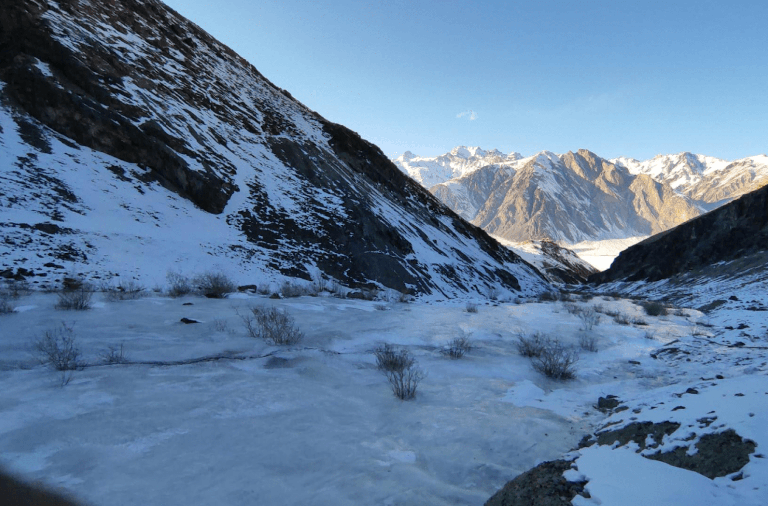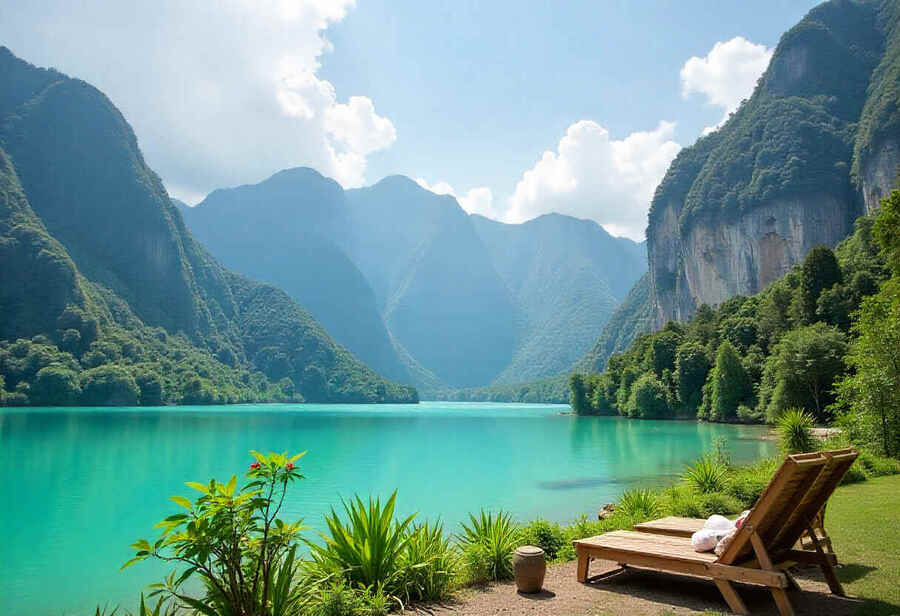Copyright Resilience

An interview with filmmaker and water conservationist Lobzang Wangtak, whose latest documentary “I Am Zanskar” is a portrait of an ecologically fragile landscape that is undergoing rapid changes. With glaciers receding at an alarming rate and erratic snowfall patterns, Ladakh’s Zanskar Valley is already witnessing some of the most dramatic climate impacts. Wangtak shares the inspiration behind the film, the community-led water conservation efforts in the region, and his dreams for a future where tourism can co-exist with conservation and preservation of the ecology and cultural traditions of Zanskar. Pooja Kishinani: Julley, Lobzang le. Thank you for joining me today. Tell us a little bit about yourself and your work in Zanskar. Lobzang Wangtak: Hello, my name is Lobzang Wangtak. I come from a region called Zanskar in Ladakh. For over 10 years, I’ve been involved in climate adaptation techniques, specifically applying different ways to intervene in water scarcity. I’ve worked on building artificial glaciers which is a technique of storing the wastewater that is otherwise wasted in the autumn and winter seasons, stocking them in the form of ice so that farmers can use it in the early spring. Then I worked on ice stupas which are now quite popular. In 2019, together with three other friends of mine, we started an organization, a trust called Navikarna Trust, which literally means “to renew”. We started working on that because it was needed in Zanskar Valley. I encountered a lot of other villages that were facing water scarcity and using techniques such as artificial glaciers or ice stupas were not really practical or possible in the context of these villages. So instead we said there’s abundant solar energy that’s available more than 300 days a year. We have sunny days plus 90% of the villages in Zanskar are along the rivers. So why not use solar energy and pumps to lift water to villages? We have done that in more than a dozen sites in Zanskar so far. But when we started off there was no organization or government efforts to do that. Now we are happy that our work has reduced because the government has taken it very seriously to tackle water scarcity using similar techniques, which is good. So yeah, that’s one of the things that I do. Another thing to share is that I moved away from home when I was five years old because there was no school in Zanskar. There were schools but they were not good enough. So I moved to Leh to get educated here and once every two or three years, I’d get to go home. I grew up in Zanskar for the first five years of my life, but most of the time after that I was away from home. I always felt nostalgic to go back home and reconnect with the place. When that happened I also saw that there were a lot of changes taking place; the little bubble that I created of memories from the past and how I imagined it to be — those were all crashing down. There were still many things that I wanted to hold onto — certain practices, stories, the ways that we used to play around, the smell of the fields, riding horses and yaks. But I didn’t know where to start. Somewhere deep inside I wanted to really protect and kind of dwell in that place of imagination and memory. A hiker sits in front of an ice stupa in the Zanskar Valley. Photo courtesy of Lobzang Wangtak Pooja: Thank you for sharing about your work and relationship with Zanskar. I think this is a good point to mention that you have recently directed a film called I Am Zanskar which premiered at the International Documentary & Short Film Festival of Kerala (IDSFFK). How was the idea or the seed for the film born?. You’ve spoken of this connection living away from Zanskar and remembering it with nostalgia. What made you want to document it through the medium of film? Lobzang: Yeah, this is a feeling I had even before we started the organization. I was working in the corporate world for one and a half years. Towards the end of my corporate career, I was posted here in Leh. I was the project manager for a program called Naropa Fellowship. Even though I was earning a decent salary and engaging with young people with lots of aspirations and ideas, somewhere deep inside I missed home. I had a feeling that I have to go back — it’s now or never. Not because it’ll go away from me, but because I really wanted to participate in this change in Zanskar because I knew the roads were going to come in, I knew there was telecommunication that’s going to come in and I know the changes that will occur in Zanskar, which has usually been cut off. Imagine, even just four or five years ago, to get to Zanskar in the middle of winter was to walk on the frozen river. Even in the summers the easiest route and the shortest route would take you 18-19 hours to reach! That’s how isolated Zanskar was. I know that in the coming years changes will happen very rapidly and there will be several things that I will miss forever in Zanskar. So I was holding on to that memory and I wanted to participate in this change. Somewhere deep inside, I think you want to contribute to the place where you come from, even if you grew up elsewhere and live in other places. There’s somewhere you always wanted to go back and contribute to. I Am Zanskar film poster I never imagined documenting this in the form of a film. I started off in 2019 just with a mobile phone, which was not a really good phone or anything. It was useful to take some decent videos. I wanted to keep recording, not with the idea of making a film. But then it gradually occurred to me — the quality is not that bad and I can keep recording and sometimes borrow cameras from my friends, or call them to help me shoot things… So I was randomly shooting things, not really realizing that it has to be a theme, a style, a linear story. When I had that idea of creating the film, I imagined a story, a documentary which is about Zanskar told by Zanskar, that is, Zanskar as the character itself — what it has gone through, its first inhabitants, the different folklore stories around it and how isolated and independent it was. Even with this harshness, people were able to produce surpluses, build monasteries and centers of education. I would say at least 60-70% of people were educated, even 40-50 years ago. All of them knew how to read script scriptures which means learning the Tibetan script. That was something I thought would disappear forever and then we will not be able to witness it. There were documentaries about Zanskar made by people who came from elsewhere, either other parts of India or somewhere from Europe. But these films were a projection of the stories of Zanskar. We were not telling our own story. And that’s an opportunity I didn’t want to miss out on. I’m not a professional filmmaker; I just wanted to keep documenting and see what happens. While we sat down to edit the documentary, we realized if it was just Zanskar narrating and explaining everything, it takes away so much of the film and I didn’t want it to be that way. We had a cut like that and we said no. The second time, we wanted to patch a lot of random footage together. I was revisiting those places in real time and then talking about what was happening in that footage or that sequence that felt like a reportage, you know. So then at the end it was really coming back to, you know, pivoting the story all about me. Why did I even start recording, you know, then came just my love for the place and the memories that will disappear forever. And this is the moment that I can capture it, you know. So that’s how the film was born. Pooja: That’s beautiful. I think the stories that you, your team and the land is telling are really important. We are at Planet Local Summit and we’ve just had a session on confronting the climate crisis. So I want to hear from you, what are some of the threats that Zanskar is facing, particularly, in terms of this land being very ecologically fragile? What are some of the threats exacerbated by the climate crisis and what are some solutions that you think are long-term and necessary? Lobzang: The most important thing that we need to understand is that within Ladakh, Zanskar has the largest freshwater reserve. It has more than a thousand glaciers in the greater Himalayan region. The volume of the Zanskar River is even higher throughout the year than the Indus River. A snowy artificial glacier is seen in the Zanskar Valley. Photo courtesy of Lobzang Wangtak We need to realize that the impact of climate change means these glaciers are directly impacted. They are receding at an alarming rate; we don’t know exactly how much. So this was an evident indicator of climate change. When I was visiting villages, I kept hearing every other villager complaining about water scarcity. That was not the case ten years ago. Even in my own village, I never heard about water scarcity. So when I started talking to people, they talked about experiencing such episodes [of water scarcity] once or twice in their lives. And these were people in their 60s and 70s. But now the weather patterns are becoming very erratic. There will be a spell of no precipitation for two or three winters, and then all of a sudden it starts snowing! Increasingly these traditional glaciers are not dependable. Precipitation in the form of snowfall is not dependable. This is the real indicator of the changing climate in the region. So the threat Zanskar is facing now is that more than 50% of villagers are facing moderate to severe water scarcity. And at the same time you have highways and 4G towers coming into that place. Progress or development in terms of infrastructure is happening at a very alarming rate. As I said four years ago, the only route was to walk on the frozen river. Now it’s open throughout the winter. That shorter route which takes about 4-5 hours is open and functional throughout the year, even in the winter. So that means our world has changed drastically within a few years. When changes happen so quickly, we end up taking measures and big leaps without realizing the consequences. Through my work and film, I really wanted to slow down and kind of process and witness these changes which are the big threats. Zanskar is facing the consequences of climate change and global warming. But now, what’s important is what the inhabitants will do and decide for this land, you know. Will it have the same fate as other towns in the Himalayas which are experiencing the impacts of unregulated tourism reaching a saturation point? I love Zanskar. It’s full of energy — young and wild. I feel like I’m serving my region, my community and so forth. That feeling grows as you become more involved and more responsible. If you had met me five years ago, I would have been full of myself. But then you grow up, you mature, and you realise that there are so many things that we need to do. Today, the roads are coming in. We are preparing for thousands of people to come in every day. But there’s no public toilet in the whole town of Padum. We don’t know what we are going to do with all the waste that would be generated. We have no town planning. We have no idea how we are going to treat waste, both liquid and solid waste. It’s like you’re building a house, you know, but after you build that house then you want the architect to come in and fix things. Learning from what happened in Leh, Kargil, Manali and Shimla, we should have learned those lessons about planning and implemented them. But infrastructural change is happening so fast. We will wait for everything to go the negative way and reach a saturation point and then talk about sustainability. We keep repeating, but we’re not learning. That is the very sad part and a very big threat. Pooja: That’s like the root of the crisis, right? We keep repeating the same mistakes. Lobzang: Yeah. Pooja: Thank you for giving us such a detailed picture of the landscape and the threats Zanskar is facing. My final question to you is, what is your biggest dream and vision for Zanskar? What is the Zanskar that you would like to live in? Lobzang: I think that activism these days shouldn’t be about fighting something. I think there needs to be a lot of collaboration, compassion, and patience. Because what are we fighting against? The system? The government? The government has no idea what to do. We have to realize that and ask what can we offer the government? Maybe it is a policy recommendation which is well-thought out, well-reviewed and well-visioned using reliable data and research. Ideally, I dream of a Zanskar which is preserved for adventure and eco-tourism. How will that happen? By convincing the government that by actually preserving and protecting this landscape is important. Because you adopt it as a sustainable tourism model, that place can only sustain so many people. As the demand rises, we collect more direct taxes from travelers who are coming in, whether they’re from India or from outside the country. Just by sitting around the government can make so much money. But we need to convince them on paper and in practice that there is a benefit to preserving this landscape. We don’t have to allow unregulated tourism activities where we exploit everything and make things worse and maybe exhaust everything that we have in the next decade or two. That convincing can happen through well-thought out vision and policy recommendations. That is where activism should be where you are partnered with the government. I don’t think we have to look at the government as this beast that just wants to do terrible things. They are short-sighted and just don’t know what they are doing. They’re not looking beyond what they can achieve in their term in power. I think there needs to be a lot of collaboration within the research community, within organizations and then a dream of Zanskar being adopted as a sustainable tourism protected area where traditional practices thrive, where it becomes a high-value and low-volume tourism attraction. Zanskar still has several beautiful trekking routes which are still preserved, which are difficult to find elsewhere in Ladakh with the number of roads that have been built. There are valleys where you don’t need roads but we need to create activities and an economy around that. The valuable thing that Zanskar can provide is this pristine landscape — high mountains and beautiful valleys which are untouched. The moment you start exploiting them, you are devaluing that place. So that is an ideal place that I would want Zanskar to be but it’s a very far-fetched dream I think. For me what matters is that 15-20 years from now, when I reflect and say I tried. I’m not stressing too much or being cynical. Pooja: I’m really inspired by the work that you do and also what you shared. All we can do is try because I feel like the systems and structures want us to be cynical so that we don’t do anything. But we have to keep trying. I am hoping that your documentary, work and vision reach as many people as possible. Lobzang: Thank you, thank you, thank you so much. Pooja: Thank you. Portrait of Lobzang Wangtak, photograph by Pooja Kishinani Lobzang Wangtak is a water conservationist and filmmaker from Ladakh, India, known for his work in climate adaptation and water conservation. He has implemented climate adaptation techniques like artificial glaciers and solar-powered pumps, and produced the documentary “I Am Zanskar,” which addresses climate change and fading traditions in the region. Pooja Kishinani is the editor and curator of Radical Ecological Democracy (RED) web journal. This article has been published against the backdrop of the ongoing Ladakhi movement for constitutional safeguards for the culture, environment and economy of the region. Since at least 2023, Ladakhis have been demanding statehood and inclusion in the Sixth Schedule of the Constitution of India that would grant them autonomy in governing the region in tune with its unique cultural and ecological conditions, and ensure they get dignified livelihoods. Here are some resources to learn more about the Ladakhis struggle for justice, safeguard and protection of their lands, culture and ecology- Ladakh violence: How government inaction on its promises on autonomy has fuelled frustration Ladakh’s battle for identity and autonomy ‘Ladakh Situation Symbolic of Larger Environmental and Social Crisis in Himalaya’: Leading Activists Teaser image credit: A snowy artificial glacier is seen in the Zanskar Valley. Photo courtesy of Lobzang Wangtak.



